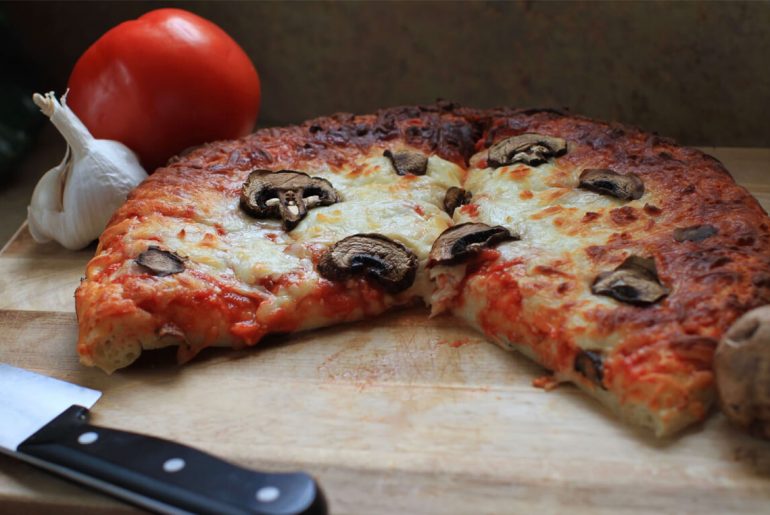(Originally published Feb. 8, 2017 for National Pizza Day)
This year you will likely eat about 23 pounds of pizza.
And you’re not alone in your cheese-laden love affair. Collectively, Americans will devour about 3 billion pizzas before the end of this calendar year.
September 20 is National Pepperoni Pizza Day, and we should take a minute to consider whether there is any other single food that has captured our cultural creativity or embraced our ever-changing, national heritage more than this versatile staple?
Pizza embodies the region where it is made. For independent pizzeria owners, it’s a labor or love. More than 75,000 pizza restaurants make up 17% of all restaurants nationwide.
In the U.S., pizza has become a passion.
But of course we know, like most foods, Americans can’t take credit for its invention.
The origins of pizza could actually be credited to anyone who first learned the secret of mixing flour with water and cooking it on a hot stone.
That was likely back in the Stone Age when crude bread would have been heated beneath the stones of a fire—but that’s hardly a food that deserves its own national day of recognition.
We really owe our pizza heritage to the Spanish Conquistadors for introducing Peruvian tomatoes to Italy—which then several centuries later made their way to North America via Italy. (Clearly, tomatoes didn’t take the path of least resistance.)
When tomatoes were introduced to Italian cuisine in the 18th and 19th centuries, the modern pizza started taking shape.
Originally, tomatoes were thought to be poisonous and were used for decorative purposes only, but starvation likely led the working poor of Naples, or lazzaroni, to begin experimenting with the potentially deadly fruit in their cooking and on their flat breads and pizzas.
And we’re all thankful they did, as pizza has never been the same since.
Pies were cooked up on the street day and night. As popularity of the new found food soared, street vendors were replaced with brick and mortar shops where patrons could order custom pizzas with a variety of toppings.
By 1830, the world’s first pizzeria, Antica Pizzeria Port’Alba, opened in the town center at Via Port’Alba 18. Many more followed.
A simple oil and garlic topping was popular with the lower income citizens, students and artists who frequented the shop. Mastunicola, topped with lard, sheep milk cheese and basic spices was another popular pie.
In 1889, the famous Naples pizza chef Raffaele Esposito was asked to make food for visiting Umberto I King of Italy and his wife Queen Margherita di Savoia. Queen Margherita is said to have enjoyed the red tomato, white cheese and and green basil pizza so much—made in the three colors of the Italian flag—Esposito named it after her. This approval could have set off an Italy-wide pizza craze, but the pies stayed largely unknown in Italy outside of Naples until the 1940s.
“The ‘pizza alla Margherita’ became suddenly fashionable in Naples, though nowhere else in Italy,” writes John F. Mariani, author of How Italian Food Conquered the World. “The word pizzeria did not even appear in Italian print until 1918, but the idea came to America via the Neapolitans who settled in the eastern cities.”
On this side of the pond, it wasn’t until the late 19th century that we were exposed to pizza’s heavenly powers. When Italian immigrants began to yearn for the dishes of the Old World, they sent for the necessary ingredients.
The first pizzeria on American soil was born in 1905 on 53 1/2 Spring Street in what is now known as New York’s Little Italy neighborhood by Italian immigrant, Gennaro Lombardi.
“As has always been the case in American immigration, the food business provided the easiest access to ownership and entry into American society,” writes Mariani.
In the subsequent three decades, handfuls of other immigrant-owned pizza shops opened up in New York, Philadelphia, New Jersey and Chicago.
Pizza didn’t go fully mainstream until after WWII, when American GIs stationed in Italy returned to home with a taste for the saucy pies they had become accustomed to overseas.
One of these soldiers, Ira Nevin, returned home to New Rochelle, New York in 1945 and combined his eating experiences in Italy with his family’s expertise in oven repair to design the first gas-fired Bakers Pride pizza oven. The ovens could bake pizzas quickly and cheaply, allowing men with the entrepreneurial spirit, to successfully open a brand new pizza shop.
As Italian-Americans, and their food, migrated from east to west, pizza’s popularity soared. Between 1945 and 1960, independently-owned pizzerias popped up all over the country. The new, quick food trend took off with workers who only had limited time for lunch breaks, as well as large families looking for a cheap, satisfying meal. Pizza also easily lent itself to late night bar menus.
Postwar pizza popularity grew across the country in the 1950s. Friday pizza nights were particularly popular with Catholics who were still forbidden to eat meat. Special cardboard boxes were created for take-out orders, a new option that made sales skyrocket.
The first frozen pizza was introduced by the Celentano Brothers in 1957, then a few years later by Rose and Jim Totino.
It was safe to say, pizza’s popularity had finally reached America, Italy and beyond.
“Like blue jeans and rock and roll, the rest of the world, including the Italians, picked up on pizza just because it was American,” explained Mariani.
Pizzas all over the world now reflect the local heritage: peas in Brazil; eel in Japan; sunny side up eggs in France; sheep in India.
And in America?
Though style varies by region, the proud, pizza-loving folks of the U.S.A. pick pepperoni as their favorite topping. And that’s just fine. Like Jazz and baseball, pepperoni is a purely American invention and our own unique contribution to the long-running history of one of the world’s most popular foods.
Love National Pizza Day? Try this homemade Roasted Red Pepper Pizza.




